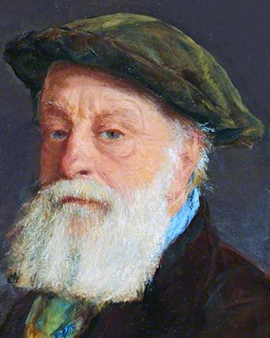James Clarke Hook was a British artist whose depictions of landscapes, seascapes and historical scenes made him a highly regarded landscape and genre painter. His mother was the daughter of the Methodist theologian and Bible scholar Dr. Adam Clarke. His father James Hook was a judge at an international Pax-Britannica court. A total of six jurisdictions had established themselves internationally, one of them in Freetown, the capital of Sierra Leone, and so James Clarke was born in the southwest African country. During his childhood he first came into contact with the maritime subject, the beauty of sailors, merchant ships and the sea fascinated the young James Clarke immensely and he began to draw. In the process he created beautiful drawings of extraordinary lightness and soon he realized that painting was his profession. Later Clarke worked in sculpture galleries of the British Museum under the guidance of visual artists such as John Constable and John Jackson. In 1836, James Clarke Hook began studying at the London Royal Academy. During his three years of study, he created his first paintings known today; in 1844, his design "Satan in Paradise" was shortlisted for the first time in a competition held by the venerable Westminster Hall for the most beautiful frescoes for the newly created Palace of Westminster. In the same year, the Academy showed Hook's erotic work "Pamphilius relating his Story", for which he had been inspired by the Decamerone.
In the middle of the 1840s, several of the painter's paintings were exhibited. They strengthened his reputation for his ability to depict romantic themes in an immensely powerful and original way. His paintings "The Song of Olden Times" and especially the award-winning "The Finding of the Body of Harold" marked the mature artistic Profession Hooks. As was customary at the time, the artist also began to undertake study trips. During his travelling studies he also created paintings with religious motifs. During this time he married the painter Rosalie Burton before he left for Paris to work in the Louvre. Hook then visited Switzerland and Italy, where he devoted himself to extensive study of the works of Titian and other Venetians. From then on, this was to influence the further design of his paintings and etchings. While romantic representations of English themes of land and sea were his trademark up to that time, Venetian themes gained great influence. In 1860, James Clarke Hook became a full member of the British Royal Academy.
Hook subsequently moved away from history painting and devoted himself to vivid genre depictions in his London domicile. Rural landscapes, coastal motifs, d and depictions of the hard life of the coastal dwellers occupied a large part of his work. Paintings like "A Widow's Son going to Sea", "The Book, Stand Clear! O Well for the Fishermans Boy!" or "Sea Urchins" established the reputation of his coastal paintings as "Hookscapes". In 1857 Hook settled in rural Godalming in the county of Surray. Here he built his country house "Silverbeck" to live there until his death on 14 Abril in 1907. His sons were also painters: Allan James Hook (1853-1946) became a marine painter and Bryan Hook (1856-1925) devoted himself to animal painting. Works by James Clarke Hook are kept at the Royal Academy of Arts and the Guildhall Art Gallery in London, as well as in galleries in Liverpool, Manchester and Aberdeen.
×





.jpg)
.jpg)
.jpg)
.jpg)
.jpg)
.jpg)
.jpg)
.jpg)
.jpg)
.jpg)
.jpg)
.jpg)
.jpg)
.jpg)
.jpg)
.jpg)
.jpg)
.jpg)
.jpg)
.jpg)
.jpg)
.jpg)
.jpg)
.jpg)
_-_(MeisterDrucke-906414).jpg)
_-_(MeisterDrucke-906414).jpg)
.jpg)
.jpg)
_-_(MeisterDrucke-548011).jpg)
_-_(MeisterDrucke-548011).jpg)
.jpg)
.jpg)
.jpg)
.jpg)
.jpg)
.jpg)
.jpg)
.jpg)
.jpg)
.jpg)
.jpg)
.jpg)
.jpg)
.jpg)
.jpg)
.jpg)
.jpg)
.jpg)
.jpg)
.jpg)
.jpg)
.jpg)
.jpg)
.jpg)
.jpg)
.jpg)
.jpg)
.jpg)
_-_(MeisterDrucke-940921).jpg)
_-_(MeisterDrucke-940921).jpg)
.jpg)
.jpg)
.jpg)
.jpg)
.jpg)
.jpg)
.jpg)
.jpg)
.jpg)
.jpg)
.jpg)
.jpg)
.jpg)
.jpg)
.jpg)
.jpg)
_-_(MeisterDrucke-1635607).jpg)
_-_(MeisterDrucke-1635607).jpg)






